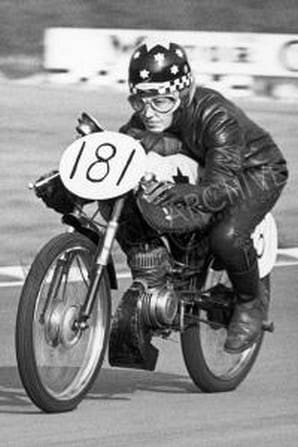
Innocenti 1947-71 Italy
Covered under Lambretta.
Invicta 1913-23 UK
Range of Villiers, JAP and Abingdon powered machines, some designed by Arthur Barnett of Francis-Barnett fame.
Enjoy more Classic MotorCycle reading in the monthly magazine.
Click here to subscribe & save.
Iso 1948-64 Italy
Founded by Renzo Rivolta as Isothermos in 1939 at Bresso. The company was reformed as Iso Autoiveicoli SpA Rivolta in 1948. Production began with autocycles and the Isoscooter/Isomoto scooters, both with 125cc split single two-stroke engines based on Puch design. Then came their micro-car which became the Isetta, the design was licensed to BMW and the French company VELAM.
Motorcycles followed including the 125/150cc Gran Turismo, a 250 (236cc) model and a 196cc shaft drive machine. The impressive 146cc Iso Diva appeared in 1957.
Sold in some export markets as the Iso Milano, it was one of ‘the’ scooters to be seen on for those for whom style was everything. A cross between a Vespa and a Lambetta the Diva is today sought by scooter fanatics.
Although Iso unveiled new 125/175cc motorcycles in 1961 and planned a 492cc BMW like machine, the introduction of Bertone and Ghia styled luxury sportscars powered by Chevrolet and Ford V-8 engines sounded the final whistle for two-wheelers. Production ended in 1963.
 Itagaki 1954-c1965 Japan
Itagaki 1954-c1965 Japan
Production began with cycle-motor units followed by scooters, mopeds, lightweight motorcycles and step-thru type machines. Never seen or heard of a survivor but according to reports were made in sizable volume therefore examples may exist.
Itala 1933-39 Italy Range of Chaise, Train, Rudge and other proprietary engined machines built by Giuseppe Navone in Turin. Also made motorcycle based three wheel delivery vehicles.
Italemmezeta 1958-66 Italy
MZ engined 98-250cc lightweights styled by Leopolda Tartarini (founder of Italjet) and built in Italy. Rare, but odd examples have surfaced.
Italjet 1966- Italy
Manufacture began with CZ and Triumph engined models by Leopolda Tartarini, then followed a link with the American former Indian dealer Floyd Clymer to build the Indian Velocette, which ended on Clymer’s death in 1970. Mini-bikes, some of which were beautifully crafted scaled down version of current superbikes and the Pack-A-Way scooter, came in the 1970s.
Wanting to build big motorcycles almost stretched Tartarini’s business to bankruptcy but it recovered to manufacture small motorcycles, fun bikes and more recently scooters. Tartarini also completed style design work for Ducati, a marque he’d been involved with 20 years earlier as a rider.
By the early 1990s Italjet were importing and re-badging Her Chee scooters built in Taiwan. Later they introduced scooters of their own manufacture including the 50/125cc Formula and the retro styled Velocifero.
Itar 1921-29 Czechoslovakia
Zubaty designed 750cc side-valve horizontally opposed flat twins for both military and civilian use built by J Janatka & Spol of Prague. Last models were powered by JAP engines. The flat twins are rare, desirable and expensive.
Ito IMC 1951-c1963 Japan
Their first model was a 247cc ohv single, then later came 124/246cc two-stroke twins. Rare in Europe, but a ‘must have’ for some classic Japanese motorcycle collectors, so consequently expensive.
Itom 1944-68 Italy
The Turin company began making cycle-motors in 1944, then a 50cc unit construction single cylinder two-stroke motorcycle in 1948, followed by 65cc versions. As enthusiasm for 50cc racing gained momentum, clubmen found the already nippy Itom an ideal racer when stripped and tuned. Commercial conversion kits were soon offered. Beryl Swain, the first lady TT solo rider, finished 22nd in the 1962 50cc TT aboard an Itom, with Charlie Mates (16th) the first Itom rider home, in a race won by Ernst Degner (Suzuki). Bill Ivy raced Itoms for Chisholms of Maidstone and Frank Sheene, while AH Tooley were keen marque dealers who marketed a range of tuning aids and accessories for the Italian lightweights.
Popular among classic racing 50cc enthusiasts, they were outclassed by Honda, Suzuki, Kreidler etc, but are still desirable little racers; the roadsters are popular too. Early roadsters had three-speed hand-change gearbox, while the later MkVII was four-speed and the MkVIII foot-change four-speed.
 Iver-Johnson 1907-15 USA
Iver-Johnson 1907-15 USA
Singles and V-twins of up to 1100cc, some later models with rear suspension. Rare and expensive.
Ivo Lola Ribar 1956-mid 1960s Yugoslavia
Vespa scooters built under licence. Survivors surface occasionally.
Ivy 1908-32 UK
Mr Newman built JAP, Precision and water-cooled Green-Precision engined models before WWI. Postwar, Ivy built pleasant 225-400cc two-strokes using their own engines and often Sturmey Archer gearboxes. Following a break in production, Ivy re-entered manufacture in the late-Twenties with JAP engined lightweights. A few veteran singles and a moderate number of vintage Ivy two-strokes survive.
Ixion 1906-23 UK
Built in Birmingham using proprietary engines including Abingdon and then Precision before adopting Peco and Villiers power just before WWI. Continued until 1923 then sold the brand to New Hudson. An earlier firm, also Ixion, were cycle makers who built pioneer machines with MMC and de Dion engines.
 IZH 1928- Russia
IZH 1928- Russia
Known by some as ISH. Derives its name from its home town Izhevsk. Essentially a company who copied the designs of others. Early 750-1200cc V-twins drew inspiration from American and British manufacturers then IZH began making ohc singles along German lines and aping DKW two-stroke design.
After WWII, production of a DKW NZ350 copy continued and was offered stripped for racing or competition work but it became progressively more dated. During the late-Fifties, IZH built successful ISDT Gold Medal winning models and other off-road competition motorcycles which bore little resemblance to their road going range.
The company introduced a new roadster range in 1961 comprising the twin-cylinder two-stroke Jupiter followed by the single cylinder two-stroke Planeta. Sold in vast numbers in Iron Curtain countries as well as limited export of Jupiter and Planeta to the west. ![]()
Advert
 Enjoy more The Classic MotorCycle reading in the monthly magazine. Click here to subscribe.
Enjoy more The Classic MotorCycle reading in the monthly magazine. Click here to subscribe.



